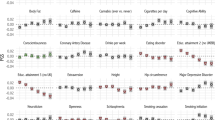Abstract
One approach to establish linkage is based on allele sharing methods for sib pairs. In recent years the use of selected sib pairs to increase power for mapping quantitative traits in humans has been discussed intensively. In this paper the different basic principles for sib pair sampling proposed in the literature are made evident. Implications for ascertainment schemes of sib pairs to minimize the total study cost in linkage analyses on reading and spelling disabilities are discussed.
Similar content being viewed by others
References
Allison DB, Faith MS (1997) Issues in mapping genes for eating disorders. Psychopharmacological Bulletin 33:359–368
Allison DB, Heo M, Schork NJ, Wong SL, Elston RC (1998) Extreme selection strategies in gene mapping studies of oligogenic quantitative traits do not always increase power. Human Heredity 48:97–197
Blackwelder WC, Elston RC (1982) Power and robustness of sib-pair linkage tests and extension to larger sibships. Communications in Statistics-Theory and Methods 11:449–484
Cardon LR, Smith SD, Fulker DW, Kimberling WJ, Pennington BF, DeFries JC (1994) Quantitative trait locus for reading disability on chromosome 6 6. Science 266:276–279
Carey G, Williamson J (1991) Linkage analysis of quantitative traits: Increased power by using selected samples. American Journal of Human Genetics 49:786–796
Collins A, Morton NE (1995) Nonparametric tests for linkage with dependent sib pairs. Human Heredity 45:311–318
Daniels SE, Bhattacharrya S, James A, Leaves NI, Young A, Hill MR, Faux JA, Ryan GF, LeSöuef PN, Lathrop GM, Musk AW, Cookson WO (1996) A genome-wide search for quantitative trait loci underlying asthma. Nature 383:247–250
Darvasi A, Soller M (1992) Selective genotyping for the determination of linkage between a marker locus and a quantitative trait locus. Theoretical and Applied Genetics 70:2000–2012
Duggirala R, Williams JT, Williams-Blangero S, Blangero J (1997) A variance component approach to dichotomous trait linkage analysis using a threshold model. Genetic Epidemiology 14:987–992
Eaves L, Meyer J (1994) Locating human quantitative loci: Guidelines for the selection of sibling paris for genotyping. Behavior Genetics 24:443–455
Elston RC (1996) 1996 William Allan award address — Algorithms and inference: The challenge of multifactorial diseases. American Journal of Human Genetics 60:255–262
Fulker DW, Cardon LR, DeFries JC, Kimberling WJ, Pennington BF, Smith SD (1991) Multiple regression analysis of sib-pair data on reading to quantitative trait loci. Reading and Writing — An Interdisciplinary Journal 3: 299–313
Gilger JW, Borecki IB, DeFries JC, Pennington BF, (1994) Commingling and segregation analysis of reading performance in families of normal reading probands. Behavior Genetics 24: 345–355
Grigorenko EL, Wood FB, Meyer MS, Hart LA, Speed WC, Shuster A, Pauls DL (1997) Susceptibility loci for distinct components of developmental dyslexia on chromosomes 6 and 15. American Journal of Human Genetics 60:27–39
Gu C, Rao DC (1997) A linkage strategy for detection of human quantitative-trait loci. II. Optimization of study designs based on extreme sib pairs and generalized relative risk ratios. American Journal of Human Genetics 61:211–222
Gu C, Todorov A, Rao DC (1996) Combining extremely concordant sib pairs with extremely discordant sib pairs provides a cost effective way to linkage analysis of quantitative trait loci. Genetic Epidemiology 13:513–533.
Haseman JK, Elston RC (1972) The investigation of linkage between a quantitative trait and a marker locus. Behavior Genetics 2:3–19
Mackinnon MJ, Georges MAJ (1992) The effects of selection on linkage analysis for quantitative traits. Genetics 132:1177–1185
Risch N, Zhang H (1995) Extreme discordant sib pairs for mapping quantitative trait loci in humans. Science 268:1584–1589
Risch N, Zhang H (1996) Mapping quantitative trait loci with extreme discordant sib pairs: Sampling considerations. American Journal of Human Genetics 58:836–843
Soubrier F, Cambien F (1994) The angiotensin I-converting enzyme gene polymorphism: implication in hypertension and myocardial infarction. Current Opinion in Nephrology and Hypertension 3:25–29
Weeks DE, Lathrop GM (1995) Polygenic disease: Methods for mapping complex disease traits. Trends in Genetics 11:513–519
Wijsman EM, Amos CI, (1997) Genetic analysis of simulated oligogenic traits in nuclear and extended pedigrees: Summary of GAW10 contributions. Genetic Epidemiology 14:719–735
Ziegler A, Hebebrand J (1998) Sample size calculations for linkage analysis using extreme sib pairs based on segregation analysis with the quantitative phenotype body weight as an example. Genetic Epidemiology 15:577–593
Ziegler A, Hebebrand J, Schäfer H (1997) A clinically orientated approach for combining concordant and discordant sib pairs. Biometrical Journal 39:263–272
Author information
Authors and Affiliations
Rights and permissions
About this article
Cite this article
Ziegler, A. Sampling strategies for model free linkage analyses of quantitative traits: Implications for sib pair studies of reading and spelling disabilities to minimize the total study cost. European Child & Adolescent Psychiatry 8 (Suppl 3), S35–S39 (1999). https://doi.org/10.1007/PL00010691
Issue Date:
DOI: https://doi.org/10.1007/PL00010691




